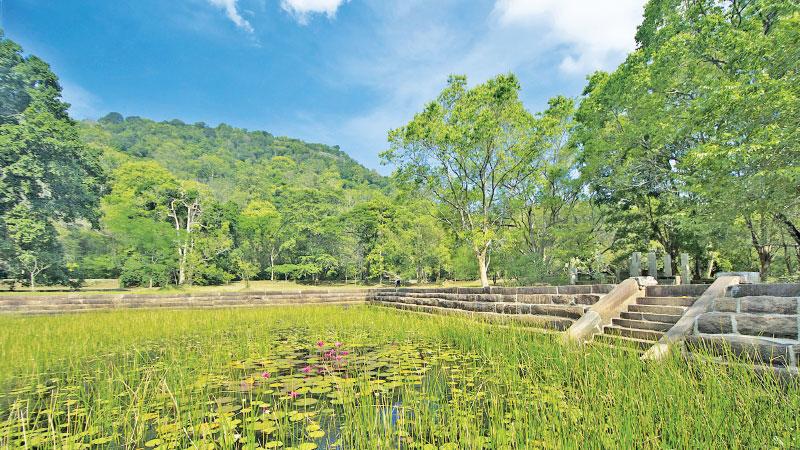
A labyrinth of paths winds its way through the forest in the hermitage at Arankele. It is dawn and misty; nippy air envelopes us. Rays of sunlight filter through the silhouetted leaves of the trees and the chirping of birds and the laughing thrushes fill the morning air as we follow the narrow jungle path, quite uninhabited in the peace and tranquility of the surroundings.
 Arankele meaning, ‘The forest of Arahats’ lies beneath a mass of rocky ridges. It is 24 kilometres north of Kurunegala, west of the Ibbagamuwa-Moragollagama Road, a half hour drive from Kurunegala. Recently, I had the opportunity to visit this beautiful place again after many years.
Arankele meaning, ‘The forest of Arahats’ lies beneath a mass of rocky ridges. It is 24 kilometres north of Kurunegala, west of the Ibbagamuwa-Moragollagama Road, a half hour drive from Kurunegala. Recently, I had the opportunity to visit this beautiful place again after many years.
I was drawn here by my life-long love of ancient places. Archaeological monuments of importance to Sri Lanka, have been central to much of my work as a photographer. This ancient site drew my attention on many an occasion, to capture its beauty through my camera lens.
Entering the Arankele archaeological site, one first witnesses the ruins of a building which has been identified as a Jantagara or a hot water bath. Among the other ruins identified are meditating promenades, ponds and winding pathways.
Wealth of nature
Scholars believe, that the kings of medieval Lanka frequented Arankele, which became the most important hermitage in the area far away from Anuradhapura. A serene and beautiful place, Arankele is enriched by the wilderness of trees, water that trickles off the hills and a bird filled sky. Walking along the stone laid pathway through a canopy of forest greens, trees and dramatic creepers climbing high or hanging low, we experience the sylvan surrounding of this hermitage which is also the home of extensive archaeological findings. Strewn in different areas of the precincts are remnants of large stone tablets on stone pillars.
The whole area is crisscrossed by stone walkways and passages along which the meditating bhikkus once walked.
One of these was the walking passage used by the austere sect of Vanavasi (forest-dwelling) bhikkus, for meditation. Called a Sakman Maluwa (walking compound), the bhikkus would proceed along it deep in meditation. When they reach the end they would turn and retrace their steps, walking back along a parallel path. Beside the path were rock seats where they could sit and contemplate.
These walking pathways which adjoin the archaeological site, are still in use by meditating bhikkus of the present Arankele Maliyadeva Senasanaya. I glimpsed a meditating bhikku engaged in a stroll in the pathway after the morning meal (alms).

Though there is evidence of three bathing ponds, only one has been completely restored. At the base of the hill, is a large pond, with beautiful pink and purple water lilies, that supported the basic requisites of the monastic bhikkus, in the past, and helped cool the air.
The 138 feet long and 107 feet wide pond made of solid stone blocks has been restored by the Department of Archaeology. Simple and beautiful, it captures the essence of Arankele, a place where a community of forest dwelling Bhikkus meditated – and still do.
A few yards away from the pond lie the ruins of a highly sophisticated lavatory system which is carefully planned and efficient in operation. Although the washroom, the toilet and the drain were all interconnected, the urinal and the toilet were located in different places.
The sixth century cave hermitage is also home to stone-built double-platform structures and ambulatories for the forest dwelling bhikkus. Typically, the platforms, aligned east-west with the entrance porch to the east, would be bridged by a large monolith. Scholars believe, they were used for meditation, ceremonies and teaching.
At the end of the long walking pathway, in a thick grove with some rocky cliffs, is a small rock cave which had been fashioned into a three roomed abode. The entrance was through a wooden door which was a replica of the original.
Spiritual abode
Parts of the original stone door frame can be seen fallen by the side. By the entrance door were two low steps flanked by a quaint miniature balustrade and stone guardstones devoid of sculpture. From the entrance hall two doors opened into two rooms on either side. Each room contained a window opening to the front and a stone slab for a bed.
This is probably where Arahat Maliyadeva lived. He was the last Arahat in the country who had dwelt and meditated several centuries ago. This was his spiritual abode surrounded by the thick forest, wild animals, birds and reptiles.
Today, this cave has been named as an archaeological monument by the Department of Archaeology. Keeping the tradition of isolation and seclusion ancient forest hermitages, even today this forest land is an abode of higher beings aspiring for spiritual advancement. I met a meditating bhikku who dwells in a kutiya (cell or abode) adjoining this ancient cave.
The best time to be at Arankele is dawn, before the heat of the day sets in. The stirring sounds of nature awakening to a new day and the crispy coolness and gentle breeze are quite invigorating. The white sand filled walking pathways give you refreshing environs. During my short stay at Arankele, I experienced a salubrious and serene atmosphere which was truly breathtaking.
